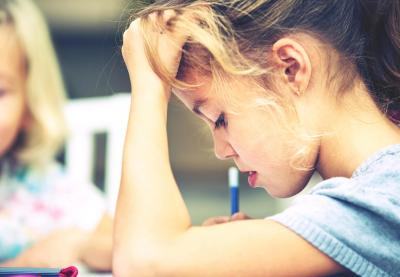I became aware of kids testing out the word racist as an insult in my first-grade classroom in the way I often hear about instances of hurt feelings: It was reported directly to me, and I overheard it myself. No one was hiding it, even as they self-consciously wrestled with its status as a “bad word.” One long afternoon culminated in two kids—one white, one black—approaching me with an acute need to talk something over right now.
After sussing out some of the particulars, it came to light that—among other instances of name-calling—the white child had been called a racist. He was, by all appearances, emotionally decimated by the accusation. With a trembling voice, he detailed the reasons he felt wronged by his friend’s accusation and elaborated that it was the worst thing he’d ever been called.
Later, when I found out that the whole thing had actually emerged from a misunderstanding—that in fact, somebody had said, “You look like you need braces”—my immediate reaction was moderate embarrassment and even a touch of relief. But by that time, it didn’t matter how it had started.
Word of the incident spread quickly, and accusations flew. “I’m not a racist!” was a common refrain, and some of the strongest defensive reactions I’ve ever seen from young kids were on undiluted display. It was less the use of the word itself (in first grade, testing out volatile words is a matter of course), and more the resulting indignation that struck such a strong chord in our little community.
In my class, we use the words racism and racist judiciously but with some regularity. The news, our curriculum and our everyday lives all provide ample opportunities to dive headlong into discussions about injustice, power and identity. So in response to the incident on the playground, we held a class meeting. We followed our typical protocol: We addressed what had happened and why, referred back to our classroom charter, came up with suggestions to remedy hurt feelings and went on to define our terms.
We asked some questions of one another: What is a racist person, and what does it mean to call someone a racist? Why does it hurt to be called one? Other questions followed: Why do certain words carry such power? Do they hurt some more than others?
The responses were insightful, and—in a very first-grade way—all over the map. They’re sorting through it all in real time, usually unfiltered. Our discussion began with (mostly white) kids expressing dismay over being on the receiving end of the word racist, but I wanted it to move beyond hurt feelings. While my students are young, they can already understand the concept that being called a word doesn’t compare to the experience of living under the thumb of injustice. Sometimes, as in this case, that needs to be pointed out directly and in context.
So we talked about the importance of looking at racism in terms of the pervasive systemic injustices we’d been studying all year. Then we discussed the fact that, historically, white people have benefitted from the imbalance of power that racism creates. Combining these two ideas helped white students begin to see that, while the existence of racism isn’t their fault, they do share a collective responsibility to put personal discomfort aside and work toward justice.
Why talk about whiteness? We can’t talk about racism without it. Use these resources to help engage students in this conversation.
During our discussion, it was hard for me not to consider when and where white fragility is born, how early it manifests and how quickly it worms its way in before full racial consciousness has even taken root. Bolstered by a reluctance to face down privilege and whiteness, it makes it difficult for us to engage honestly and clearly on these important topics.
How can we move the conversation toward justice if the mere notion of maybe being considered racist was too painful for my first-grade students to face? Their hurt feelings and defensiveness were responses I’d seen in adults, but I was struck to see them in children too young to truly understand the implications.
Coming to terms with the understanding that “you are not racist, but your identity is inextricably linked to privilege and racism in this country” is tricky for white children. But their youth is a great asset. They relish responsibility and self-reflection, and are poised to balance and contrast their own journey of racial awareness with the larger context of racism in this country.
Our class discussions weren’t always comfortable. My students shifted awkwardly, feeling the gravity of wrestling with big and painful concepts. One white child explained to me that he didn’t “want to be like those screaming mad white people” he’d seen in photographs of Ruby Bridges’ first day at William Frantz Elementary School in 1960.
Pointing the lens at one’s own whiteness, particularly when a situation necessitates it, may not be easy. The nuance surrounding both the concept and usage of the word racist might seem prohibitively complex for a first-grade class. But, as with most of the difficult moments in an elementary classroom, the seed was sown for growth. Guided by their powerful drive to rectify injustice, my students pushed through their unease.
As they came to better understand what racism is and who it affects, I trust that my white students saw that they can transform their discomfort and painful feelings into allyship instead of defensiveness or withdrawal. Facing their fragility head-on is a crucial step away from it and toward not only empathy but, I hope, action and change.
Turner is a writer, musican and former educator.
